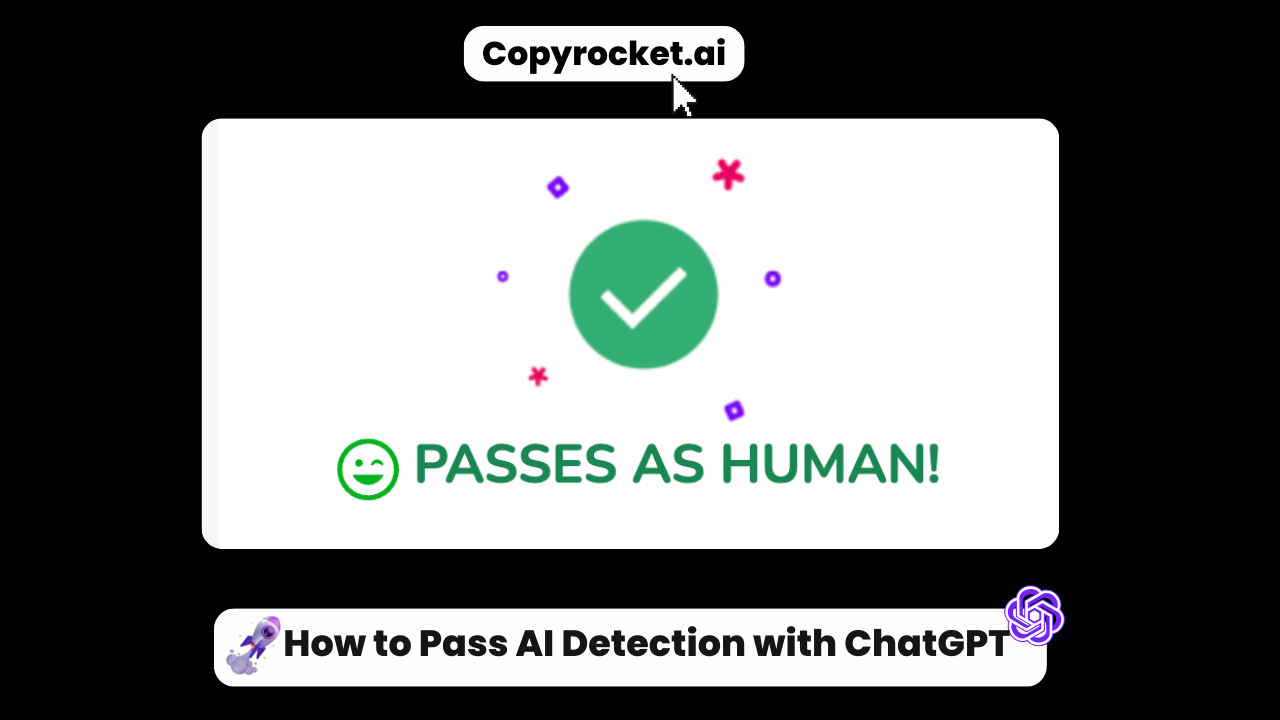In the rapidly evolving landscape of artificial intelligence (AI), the ability to generate human-like text has significantly improved, courtesy of advanced AI models like ChatGPT.
However, alongside this advancement, AI detection tools have also grown sophisticated, able to discern AI-generated content from human-written content. This paper provides a comprehensive guide on how to pass AI detection with ChatGPT.
Throughout this guide, we will explore different techniques to avoid AI detection, including incorporating personal anecdotes and adjusting writing style to avoid formulaic language.
We will also discuss the use of certain words and sentence structures that can help in passing AI detection. So, whether you’re an AI enthusiast, or an SEO agency looking for accurate results, this guide is your pathway to mastering AI detection with ChatGPT.
How AI Detection Works
AI detection primarily operates by analyzing statistical patterns, sentence structures, and repetitive or formulaic language in content to distinguish between AI-generated text and human-written text. Advanced AI models like ChatGPT, which leverage Natural Language Processing, can generate human-like text that often passes AI detection.
However, bypassing AI detection is not straightforward and requires a deep understanding of how these detection tools function and strategic adjustment of writing style to make AI-generated content resemble human-written content.
This includes the incorporation of personal anecdotes and unique phraseology. The following sections will delve into the nuances of AI detection tests, offering strategies to pass AI detection with ChatGPT effectively.
Strategies to Pass AI Detection with ChatGPT
Now, let’s explore effective strategies for successfully passing AI content detection.
Master Prompt By Copyrocket
If you’re creating content using chatGPT, then you may see your content get detected by AI detectors out there, to bypass AI detection, we have crafted the perfect prompt to tackle it, if you want to build the content you must define custom tone, voice to ChatGPT such that it can imitate it and provide unique content in your custom voice.
First, you need to command ChatGPT what you want from it, for example, social media post, Blog post or web copy, afterwards add the following command.
I want you to write the content in conversational tone, add more personalization i.e. I, You, Yours, add some facts in between, also add some humour if applicable. The content should be unique and you have never written before, add more personalization as human is writing, i want you to check spellings, grammar before providing the output. I want you to not repeat any step or section, double check before pasting it.
Now, use the AI content detector of your choice and paste your content and check if it is AI or human-written text;

As you can see yourself, it passes as humman like text.
Also read, How to Add ChatGPT to Excel (2 Simple Steps)
Fine-tuning ChatGPT
The primary purpose of fine-tuning is to make the AI-written content more human-like. ChatGPT writes in a way that reads naturally and feels like a human wrote it. Fine-tuning also reduces the instances of formulaic language, making it difficult for AI tools to detect AI-generated content.
Avoid Some Words
Studies show that AI-generated text frequently includes certain phrases like “Moreover,” “Furthermore,” “Additionally,” and “In conclusion.” These words are commonly used by ChatGPT and can be flagged by AI detectors, even if the text is manually written. It is important to be mindful of such phrases to avoid potential misidentification.
Human Touch
Incorporate personal anecdotes and unique phraseology in the content created by ChatGPT. This strategy adds a human touch, making the AI content seem more like human-generated. This makes it less likely to be detected by AI detectors. The use of personal anecdotes and colloquial language can also help make the content appear more human-like.
Paraphrasing
Using a paraphrasing tool can help to create varied sentence structures and use of synonyms. This leads to significant improvements in bypassing AI detectors as it makes the content less predictable, consequently making it harder for AI content detection algorithms to identify instances of AI-generated content.
Avoid Repetition
AI detection platforms heavily rely on spotting patterns and repetitions. Craft your responses with ChatGPT in a way that they are diverse and don’t follow a strict pattern. This practice will help in avoiding AI detection.
Keep Updating
AI systems, including detection tools and language models like GPT-4, keep improving. Stay updated on these machine learning advancements and continuously fine-tune your strategies to bypass AI detection.
Limit False Positives
AI sometimes gives false positives while trying to detect AI-generated content. To limit these, ensure the content generated by ChatGPT is rich in context and specific details. SEO agencies can especially benefit from this, as undetectable AI-written content can drive substantial organic traffic without showing ads.
Avoiding Formulaic Language
AI detection also looks for repetitive or formulaic language, which is commonly found in AI-generated content. To pass this test, it is necessary to avoid using templates and generic phrases. Instead, focus on creating unique content that includes personal experiences and opinions.
Sentence Structure
AI detection also analyzes the structure of sentences to distinguish between AI-generated and human-written content. To avoid detection, it is crucial to vary sentence length and structure, as well as incorporate complex sentence structures that may not be common in AI-generated text.
Statistical Analysis
AI detection algorithms use statistical analysis to compare word and phrase frequency in AI-generated content with human-written text. To pass this test, include uncommon vocabulary, varied sentence structures, and synonyms. Use diverse language to bypass statistical analysis.
Also learn, How to Roleplay with Character AI (5 Tips)
Ethics and Constraints in Duplicating Human Intelligence
While we have seen significant improvement in AI models like ChatGPT, it’s essential to consider the ethical implications and limitations of replicating human intelligence. AI models are designed to mimic human cognition, but they cannot fully replicate the depth and diversity of human thought.
One limitation lies in the ability to detect whether content is AI-generated or human-written. Despite advancements in AI detection algorithms, we experience false positives and negatives, meaning human-generated content can be mistakenly flagged as AI; conversely, AI-generated content can pass undetected.
Furthermore, there are ethical concerns regarding the indistinguishable line between AI and human-generated content. It raises issues about authenticity, accountability, and consent.
For instance, if AI-generated content leads to misinformation or harm, who is held accountable?
It’s also worth noting that AI, by design, lacks the personal experiences and emotions that fundamentally shape human communication. Hence, it can’t fully replicate the depth of human expression, making a clear-cut distinction between AI-generated and human-generated content crucial for transparency and ethical considerations.
Also learn, How to Bypass ChatGPT Restrictions (5 Ways)
Tools To Bypass AI Detectors
Here are six other tools apart from ChatGPT, that can aid in bypassing AI detectors, and making significant improvements in how AI-generated content is perceived:
Quillbot
Quillbot is a great tool that could help bypass AI detection software. This language model utilizes advanced AI algorithms to paraphrase your text, making it appear as if it were written by a human. It’s an ideal solution for making significant improvements to the originality of AI-generated content, increasing the chances of passing the Turing Test.
Spinbot
Spinbot is another efficient AI tool designed to rephrase your content. By modifying sentence structures and using synonyms, Spinbot helps to create text that is diverse and less likely to be flagged by an AI detector. It’s a valuable resource for those looking to disguise AI-generated content as human-written.
Stealth Writer
Stealth Writer uses a language model that can generate human-like content, making it harder for AI systems to detect. Not only does it provide fresh content, but it also ensures that the tone, style, and context align with the required output. As a result, the AI-generated content appears more human and less detectable.
UndetectableAI
UndetectableAI stands true to its name, aiming to produce AI-generated content that can pass off as human-generated. This AI system uses advanced language models that are trained on a wealth of data, giving it the ability to mimic human writing convincingly.
If you’re aiming for content that is harder for an AI detector to identify, UndetectableAI is a powerful tool to consider.
Chimp Rewriter
Last but not least, Chimp Rewriter is a versatile AI tool capable of spinning content to a point where it appears human-written. This tool can make significant changes to the structure and word choice in your text, making it a valuable asset when trying to bypass AI content detection.
It’s a testament to how far AI has come in generating content that not only passes the Turing test but also imitates human writing effectively.
These tools offer a promising way to bypass AI detection by generating content that closely resembles human writing.
While they’re excellent resources, it’s vital to remember that other tools and tailored strategies might be needed to consistently pass AI detection tests.
Also learn, How to Use ChatGPT to Write a Research Paper
Conclusion
Understanding how to bypass AI detectors is crucial in the ever-evolving landscape of AI technologies. This is especially true when using advanced language models like ChatGPT.
These above-given strategies will help you in making the content less predictable and harder for AI tools to detect. With these approaches, ChatGPT can pass originality tests and provide helpful responses that withstand AI detection tools.
Frequently Asked Questions
What is AI-generated content?
AI-generated content refers to text, images, videos, or any other type of content that has been created by an artificial intelligence algorithm rather than a human. AI-generated content can range from simple sentences to complex articles, and in many cases can closely mimic human-created content.
Why is it important to bypass AI detectors?
Bypassing AI detectors is significant in scenarios where you want the AI-generated content to be perceived as human-written. For instance, SEO agencies can benefit from undetectable AI-written content to drive organic traffic.
What strategies can I use to make my AI-generated content more human-like?
You can make your AI-generated content more human-like by incorporating personal experiences and opinions, using varied sentence structures and length, avoiding formulaic language, and using diverse language to bypass statistical analysis.
How do AI Detection Tools determine if the content is AI-generated?
AI Detection Tools primarily use statistical analysis and pattern detection to identify AI-generated content. They look for characteristics such as repetitive or formulaic language, uniform sentence structure and length, and unusual word or phrase frequency, which are common in AI-generated text.


